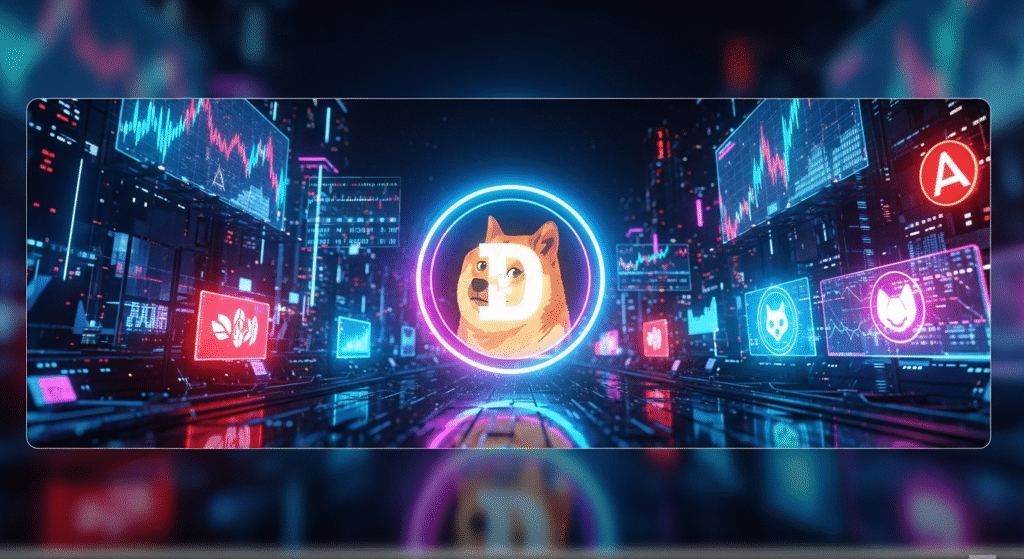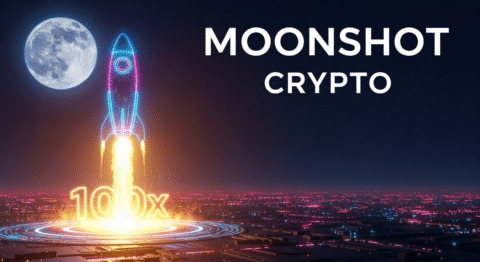Are you tired of watching the crypto market fluctuate wildly, wondering how to turn those wild swings into consistent profits, especially within the burgeoning altcoin space? Does the sheer volume of new tokens and projects leave you feeling overwhelmed, perhaps even questioning if there’s a simpler, more strategic approach to unlocking altcoin gains? What if I told you that understanding certain “secrets” of popular coins like Dogecoin could dramatically shift your perspective and empower you to navigate the altcoin landscape with newfound confidence? For those who have been tracking the trajectory of digital assets, the Dogecoin Price is more than just a ticker symbol; it’s a gateway to understanding the dynamics that drive many successful altcoin ventures.
The cryptocurrency market, ever the chameleon, continues to evolve at a blistering pace. While Bitcoin and Ethereum often dominate headlines, the real explosive growth and opportunity for savvy investors often lie within the vast universe of altcoins. These alternative cryptocurrencies, ranging from established utility tokens to the wildly popular meme coins and the emerging world of airdrops, present a unique set of challenges and rewards. In this comprehensive guide, we’ll pull back the curtain on the often-misunderstood world of altcoins, revealing three key secrets that can illuminate your path to profitability.
Crypto Market Overview
The current cryptocurrency landscape is a dynamic tapestry woven with threads of innovation, speculation, and evolving investor sentiment. We’re witnessing a continued surge in interest surrounding altcoins, with many projects gaining significant traction beyond the shadow of Bitcoin. The altcoin market, in general, has shown remarkable resilience and growth potential, with sectors like Decentralized Finance (DeFi), Non-Fungible Tokens (NFTs), and Layer-2 scaling solutions consistently attracting capital and developer attention.
Meme coins, often born from internet culture and community-driven hype, continue to capture public imagination and significant trading volumes. While their inherent volatility is a known factor, their ability to rally based on social media trends and viral marketing underscores a powerful, albeit unpredictable, market force. Recent market indicators suggest a strong appetite for high-risk, high-reward opportunities, particularly among younger demographics who are more attuned to the cultural underpinnings of these digital assets.
The world of airdrops is also experiencing a renaissance. Projects are increasingly utilizing airdrops as a potent marketing tool to distribute tokens, reward early adopters, and foster decentralized governance. This has led to a significant increase in the number of potential airdrops available to participate in, creating new avenues for users to acquire cryptocurrency without direct investment, though often requiring engagement with new platforms and protocols. Understanding these trends is crucial for anyone looking to capitalize on the altcoin market effectively.
The Core Concept: How Altcoins Actually Work
To truly harness the potential of altcoins and understand how to profit from their movements, it’s essential to grasp their foundational principles and how they differ from traditional cryptocurrencies. The insights gleaned from studying the Dogecoin Price offers a compelling case study into a successful, community-driven altcoin, and many of these lessons are transferable across the board.

What Are Altcoins / Meme Coins / Airdrops?
Let’s break down these terms to provide a clear understanding:
- Altcoins: This is a broad category encompassing all cryptocurrencies other than Bitcoin. The term is a portmanteau of “alternative” and “coin.” Altcoins emerged as developers sought to improve upon Bitcoin’s perceived limitations or explore new use cases for blockchain technology. They can range from cryptocurrencies focused on smart contracts (like Ethereum), privacy (like Monero), or specific industry applications.
- Meme Coins: These are a sub-category of altcoins that often originate from internet memes or are driven by online communities and social media trends. Dogecoin, with its Shiba Inu mascot, is the quintessential example. While many meme coins initially lacked a sophisticated utility, their value can skyrocket due to viral marketing, celebrity endorsements, and organic community support. They often prioritize community engagement and entertainment over complex technological innovation, though some are beginning to integrate more utility features.
- Airdrops: In the cryptocurrency realm, an airdrop is a promotional event where new or existing cryptocurrencies are distributed freely to a community of wallet holders or participants. Projects often conduct airdrops to distribute tokens to a wider audience, incentivize early adoption, build a community, or reward users for performing specific tasks (like holding a certain token, using a platform, or participating in a survey). While seemingly “free money,” airdrops often require users to actively engage with new blockchain protocols or tokens to qualify, thereby acting as a form of decentralized marketing and community building.
Key Components & Technologies
The underlying technology powering most altcoins, meme coins, and the platforms that facilitate airdrops is blockchain technology. While Bitcoin pioneered this distributed ledger system, altcoins have explored and built upon its principles in various ways:
- Blockchain Technology: At its core, a blockchain is a decentralized, immutable, and transparent ledger of transactions distributed across a network of computers. Each block contains a list of transactions, and once a block is added to the chain, it cannot be altered without the consensus of the network, ensuring security and trust.
- Consensus Mechanisms: While Bitcoin uses Proof-of-Work (PoW), many altcoins have adopted or developed alternative consensus mechanisms. Proof-of-Stake (PoS), Delegated Proof-of-Stake (DPoS), and Proof-of-Authority (PoA) are common examples. These mechanisms aim to improve energy efficiency, transaction speed, and network scalability. For instance, understanding the consensus mechanism of a coin influences its transaction fees and confirmation times, directly impacting its usability and Dogecoin value.
- Smart Contracts: Platforms like Ethereum introduced smart contracts, self-executing contracts with the terms of the agreement directly written into code. These enable the creation of decentralized applications (dApps), DeFi protocols, and the issuance of new tokens—many of which are distributed via airdrops.
- Tokenomics: This refers to the economic design of a cryptocurrency token. It encompasses factors like total supply, distribution methods, inflation/deflationary mechanisms, utility within its ecosystem, and staking rewards. Sound tokenomics are crucial for a token’s long-term sustainability and value. For example, Dogecoin’s unlimited supply is a unique tokenomic feature that differentiates it from many other cryptocurrencies.
The Data-Driven Perspective
To move beyond speculation and towards informed decision-making, a data-driven approach is paramount. Analyzing market trends and understanding the intrinsic value drivers of a cryptocurrency are critical for profitable altcoin investing. Lessons from the fluctuation of the Dogecoin Price can offer powerful insights here.
Market Data & Trends
The altcoin market is characterized by its diversity and rapid evolution. Here’s what the data is telling us:
- Altcoin Market Cap Dominance: While Bitcoin and Ethereum often hold the largest shares of the total crypto market capitalization, altcoins as a collective represent a significant and growing portion. Data from CoinMarketCap or CoinGecko consistently shows that the combined market cap of altcoins can outperform Bitcoin during certain market cycles, particularly when established altcoins with strong utility narratives or newer meme coins capture investor attention.
- Sector-Specific Growth: We’ve observed substantial growth in specific altcoin sectors. DeFi tokens, for instance, have seen their total value locked (TVL) soar, indicating increased user adoption and capital flowing into decentralized lending, borrowing, and trading platforms. Similarly, utility tokens powering blockchain infrastructure or gaming ecosystems have demonstrated strong performance, often tied to the adoption of their underlying technologies.
- Meme Coin Volatility and Correlation: Meme coins, while notoriously volatile, often exhibit a high correlation with social media sentiment and online discussions. Tracking metrics like social media mentions, search trends (e.g., Google Trends), and community engagement on platforms like Reddit and Twitter can provide leading indicators of potential price movements, though this is a high-risk strategy. The famous rallies in the Dogecoin value are prime examples of this correlation.
- Airdrop Participation Rates: The number of participants in significant airdrop campaigns can offer insights into the general interest in new blockchain projects. High participation rates often signal strong community interest and potential for network growth for the token being airdropped.
Tokenomics & Market Health
Tokenomics are the bedrock of a cryptocurrency’s potential for long-term value. Understanding these economic models is crucial:
- Supply and Demand Dynamics:
- Limited Supply vs. Unlimited Supply: Cryptocurrencies with a capped supply, like Bitcoin, can potentially benefit from scarcity as demand increases. Altcoins with inflationist models, like Dogecoin’s unlimited supply, rely heavily on continuous demand growth to maintain or increase their value. Analyzing the rate of inflation and adoption is key.
- Distribution: How tokens are initially distributed (e.g., through ICOs, IEOs, or airdrops) and how they are held (e.g., concentrated in a few wallets vs. widely distributed) can impact price stability and decentralization.
- Utility and Real-World Use Cases: Does the altcoin have a tangible purpose beyond speculation? Tokens that power decentralized applications, facilitate transactions on a blockchain, offer governance rights, or provide access to unique services tend to have a more sustainable value proposition. For example, tokens used for transaction fees on a busy blockchain or those that grant access to exclusive content can build inherent demand.
- Staking and Yield Generation: Many altcoins offer staking rewards, where holders can lock up their tokens to support network security and earn more tokens. This incentivizes holding and can reduce the circulating supply, potentially supporting the Dogecoin value and other staking-enabled altcoins.
- Vesting Schedules and Lock-ups: For tokens issued through sales or to early team members, understanding vesting schedules is vital. If large amounts of tokens are unlocked abruptly, it can lead to significant sell pressure and price drops.
Risks, Challenges & Competition
Navigating the altcoin market requires a keen awareness of the inherent risks and the competitive landscape. Ignoring these factors can lead to significant financial setbacks.
Risks of Altcoins and Meme Coins
- Extreme Volatility: Altcoins, especially meme coins, are notorious for their price swings. They can experience meteoric rises followed by sharp crashes within very short periods, often driven by sentiment rather than fundamentals. This makes them highly speculative assets.
- Security Vulnerabilities: New and less-established altcoins may have coding flaws or smart contract vulnerabilities that attackers can exploit, leading to loss of funds. Auditing and rigorous security practices are crucial for any altcoin project.
- Regulatory Uncertainty: The regulatory status of cryptocurrencies, particularly altcoins, is still evolving globally. Unforeseen regulations could impact the legality, trading, or development of an altcoin, leading to price depreciation.
- Market Manipulation: Due to their often lower liquidity and smaller market caps compared to Bitcoin, altcoins can be more susceptible to “pump and dump” schemes, where coordinated groups artificially inflate the price before selling off their holdings.
- Lack of Utility and Sustainability: Many altcoins, particularly meme coins, lack a clear use case or sustainable economic model. Their value is often driven by hype, which can fade quickly, leaving investors with worthless tokens.
How Does Dogecoin Stack Up Against Competitors?
Dogecoin, while a pioneer in the meme coin space, faces a dynamic and competitive environment. Here’s a look at how it compares to other altcoins and meme coins:
| Feature | Dogecoin (DOGE) | Litecoin (LTC) | Shiba Inu (SHIB) | Ethereum (ETH) |
|---|---|---|---|---|
| Origin | Internet meme, community-driven | Fork of Bitcoin, “silver to Bitcoin’s gold” | Internet meme, “Dogecoin killer” | Smart contract platform, decentralized applications |
| Use Case | Payments, tipping, community | Faster, cheaper Bitcoin transactions | Community, potential DeFi/NFT ecosystem | Smart contracts, dApps, DeFi, NFTs, NFTs |
| Supply | Unlimited, ~5 billion new coins annually | Capped at 84 million | Highly inflationary, 1 quadrillion initially, but ~50% burned | Base fee mechanism with probabilistic burning, no hard cap but supply can decrease |
| Technology | Scrypt mining algorithm, based on Luckycoin | Scrypt mining algorithm, faster block times | ERC-20 token on Ethereum, moving to Shibarium Layer-2 | Proof-of-Stake (PoS), Solidity for smart contracts |
| Community | Very strong, active, and meme-focused | Established, focus on utility | Extremely strong, loyal, and community-driven | Large, diverse, developer-centric, and investor base |
| Volatility | High | Moderate to High | Extremely High | High, but generally less volatile than meme coins |
| Competition | Other payment-focused cryptos, meme coins | Bitcoin, other fast transaction coins | Other meme coins, emerging layer-2 projects | Solana, Cardano, Polkadot, etc. |
- Dogecoin vs. Litecoin: Both use Scrypt mining, but Litecoin has a capped supply and enjoys a longer track record of utility as a faster payment network. Dogecoin’s primary advantage is its massive community and meme power, which can drive adoption for payments and tipping.
- Dogecoin vs. Shiba Inu: Shiba Inu emerged as a direct competitor to Dogecoin, aiming to build a broader ecosystem including a decentralized exchange (ShibaSwap) and DeFi capabilities. While both are meme coins, SHIB’s initial tokenomics (massive supply, burning mechanisms) and ecosystem development differentiate it.
- Dogecoin vs. Ethereum: This is a “different leagues” comparison. Ethereum’s core innovation is its smart contract functionality, enabling a vast ecosystem of applications. Dogecoin’s appeal is primarily as a digital currency and a community phenomenon, not as a platform for building decentralized services.
Understanding these comparisons helps to contextualize the Dogecoin Price within the broader altcoin market and identify its unique strengths and weaknesses.
The Future Outlook
The future of altcoins, meme coins, and airdrops is intrinsically linked to broader technological advancements, market sentiment, and regulatory clarity. While predicting specific price movements is impossible, several trends suggest continued innovation and opportunity.
What’s Next for Altcoins / Meme Coins / Airdrops?
- Increased Utility and Integration: We’re likely to see a continued push for altcoins to develop and demonstrate real-world utility beyond pure speculation. This includes further integration into DeFi, gaming, supply chain management, and other industries. Meme coins that can successfully pivot to incorporate functional use cases or robust ecosystems will likely fare better in the long term.
- Layer-2 Solutions and Scalability: As blockchain networks become more congested, Layer-2 scaling solutions will become increasingly important for altcoins. These technologies aim to process transactions faster and cheaper, improving the user experience and enabling wider adoption. This will be crucial for projects relying on high transaction volumes or micro-transactions, impacting the Dogecoin value from a usability perspective.
- Regulatory Maturation: As governments worldwide develop clearer regulatory frameworks for cryptocurrencies, this will provide greater certainty for investors and developers. While some regulations may limit certain activities, they can also foster greater institutional adoption and protect consumers, leading to a more mature and stable altcoin market.
- Evolving Airdrop Strategies: Airdrops will likely continue to be a popular marketing tool, but we may see more sophisticated and targeted airdrop strategies. Projects might reward users who actively participate in their ecosystem, contribute to governance, or provide valuable feedback, rather than just simple token giveaways.
- Focus on Decentralized Governance: As the crypto space matures, decentralized governance models, where token holders have a say in a project’s future, will become more prominent. Altcoins that empower their communities through effective governance mechanisms are likely to build more engaged and resilient ecosystems.
The lessons learned from tracking the Dogecoin Price continue to inform how we view the potential and pitfalls of other altcoins.
Conclusion
Navigating the altcoin market, from understanding the ebb and flow of the Dogecoin Price to identifying promising new projects, requires a blend of seasoned analysis and an open mind to innovation. We’ve explored the core concepts, delved into the data-driven insights, and highlighted the inherent risks.
The three key secrets we’ve uncovered are:
- Community is King: The power of a strong, engaged community cannot be overstated, as demonstrated by Dogecoin’s enduring popularity.
- Utility Drives Long-Term Value: While hype can create short-term gains, sustainable projects are built on real-world use cases and robust tokenomics.
- Risk Management is Paramount: Volatility, security, and regulatory uncertainty are ever-present. Diligence and a strategy for managing these risks are essential for preserving capital and capturing profits.
The altcoin market remains a frontier ripe with opportunity for those willing to do their homework. By staying informed about market trends, understanding tokenomics, and adopting a cautious yet opportunistic approach, you can position yourself to potentially profit from the dynamic world of cryptocurrencies.
What are your thoughts on the current altcoin market? Which altcoins are you most excited about, and what strategies do you employ for profit? Share your insights in the comments below! For more deep dives into crypto trading secrets and market analysis, be sure to subscribe to our newsletter or explore our related articles on altcoin strategies and meme coin breakdowns.
FAQs
Q1: Is it too late to invest in altcoins?
No, it’s never too late to invest in altcoins, but timing and strategy are crucial. The market is constantly evolving, with new projects emerging and existing ones adapting. Researching the Dogecoin value and its historical performance can offer insights into how even seemingly unlikely assets can gain traction. Focus on projects with solid fundamentals and clear use cases.
Q2: How much of my portfolio should be allocated to altcoins?
This depends heavily on your risk tolerance and investment goals. Altcoins are generally considered higher risk than Bitcoin. Many financial advisors suggest allocating a smaller, more speculative portion of your portfolio to altcoins, while keeping the majority in more established assets or traditional investments. Start small, learn, and adjust as you gain experience.
Q3: Are airdrops a reliable way to make money?
Airdrops can be a supplementary way to acquire cryptocurrency, but they are rarely a primary source of income. While some airdrops can be valuable, many are for low-value tokens or require significant time and effort to participate. Treat them as a bonus rather than a guaranteed profit. Always be wary of scams asking you to send crypto to receive an airdrop.
Q4: What’s the difference between a utility token and a security token?
A utility token is designed to provide access to a product or service within a specific blockchain ecosystem (e.g., paying for transaction fees, accessing features). A security token, on the other hand, represents ownership in an asset or company, similar to stocks, and is subject to securities regulations. The classification can be complex and is often determined by regulatory bodies.
Q5: How can I stay updated on the latest altcoin news and trends?
Following reputable cryptocurrency news outlets, market analysis platforms (like CoinMarketCap, CoinGecko), and engaging with active cryptocurrency communities on social media (Twitter, Reddit) are excellent ways to stay informed. Paying attention to how the Dogecoin Price reacts to news can also teach you valuable lessons about market dynamics.






